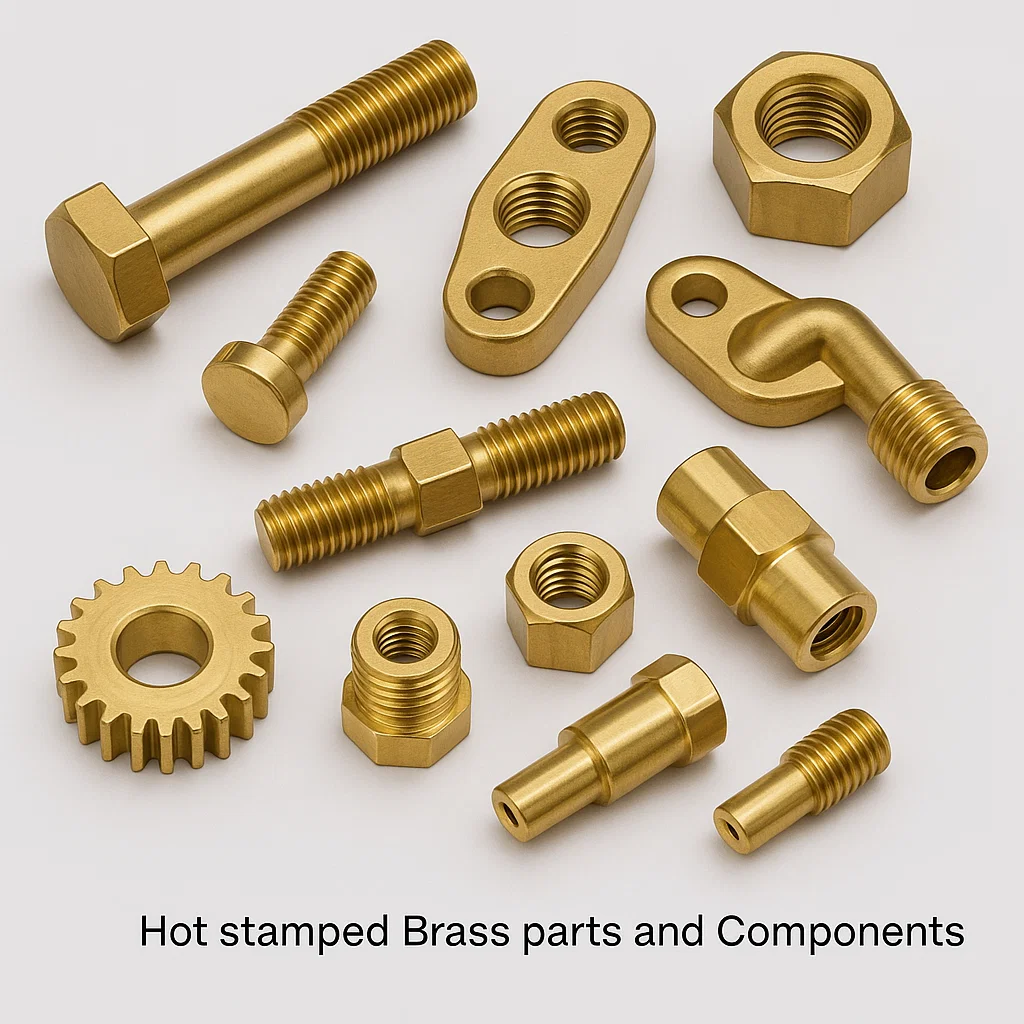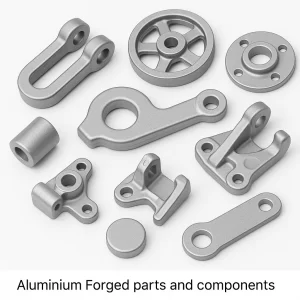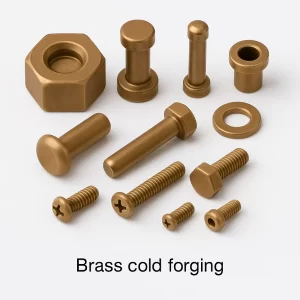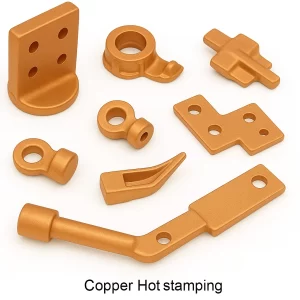Comprehensive Overview of Hot Stamped Brass Parts and Components
We are one of the leading manufacturers and exporters of Hot Stamped Brass Parts, Hot Forged Brass Components, and Precision Brass Hot Stampings from India. We supply high-quality hot stamped brass terminals, hot forged brass connectors, brass automotive components, brass electrical parts, brass plumbing fittings, brass fasteners, brass valve components, and custom hot stamped brass parts to global markets. Our manufacturing facility specializes in producing premium brass hot stampings using advanced hot forging presses, closed-die hot stamping, progressive hot stamping, CNC machining, heat treatment, surface finishing, and comprehensive quality control systems. We serve diverse industries including automotive and transportation (electrical terminals, sensor housings, battery components), electrical and electronics (connectors, bus bars, terminal blocks, switchgear), plumbing and sanitation (valve bodies, fittings, compression components), hardware and fasteners (bolts, nuts, specialty fasteners), industrial equipment (hydraulic components, pneumatic fittings, machinery parts), marine and offshore (corrosion-resistant components, deck hardware), construction (architectural hardware, decorative fittings), and general engineering (brackets, clamps, custom components). Our expertise encompasses various brass alloys including Free Cutting Brass C36000 (excellent machinability), Cartridge Brass C26000 (superior hot formability), Forging Brass C37700 (optimized hot working), Naval Brass C46400 (marine applications), Lead-Free Brass (RoHS/NSF compliant), and custom brass alloys. We manufacture hot stamped brass components ranging from 5 grams to 5 kg with dimensions 10mm to 500mm, maintaining tensile strength 350-600 MPa, excellent dimensional accuracy ±0.5-2mm (as-forged), close tolerance ±0.05-0.3mm (machined), compliance with ASTM, SAE, DIN, ISO, RoHS standards, and reliable high-volume production capability 10,000 to 5,000,000+ pieces annually.
What is Hot Stamping/Hot Forging of Brass?
Process Definition
Hot Stamping: Metal forming process where brass is heated to elevated temperature (600-800°C) then formed in closed dies under high pressure, creating near-net-shape components with excellent mechanical properties and grain flow. Alternative Terms: Hot forging, hot pressing, impression die forging, closed-die forging. Result: Strong durable parts with grain structure aligned to part contours, minimal machining required, economical high-volume production.
Hot Stamping vs. Other Forming Methods
Versus Cold Forging: Hot stamping allows larger deformation (60-90% vs 30-60% cold), lower forming pressures, suitable for complex shapes, work hardening eliminated through recrystallization, better for thicker sections >10mm. Versus Casting: Hot stamping produces superior mechanical properties (30-50% stronger), no porosity or defects, tighter tolerances ±0.5-1mm vs ±1-3mm cast, better surface finish Ra 3.2-6.3 µm vs 6.3-12.5 µm. Versus Machining: 60-80% material savings versus machining from bar, faster production (10-100 pieces/hour vs 1-10 pieces/hour machined), economical for volumes >5,000 pieces, grain flow optimization increasing strength 20-40%.
Process Advantages
Material Efficiency: Near-net-shape reducing machining, 90-95% material utilization vs 30-60% machining, flash typically 5-10% of part weight (recyclable). Superior Properties: Grain flow following part contours, 30-50% stronger than cast equivalents, fatigue life 50-100% longer than machined from bar. High Production: Automated hot forging lines 50-200 pieces/hour, consistent part-to-part quality, economical for volumes >10,000 pieces annually.
Brass Alloys for Hot Stamping
Forging Brass C37700 (60% Cu, 39% Zn, 1% Pb)
Composition: 60% Copper, 39% Zinc, 1% Lead. Properties: Tensile strength 380-520 MPa (forged and heat treated), excellent hot forging characteristics, good machinability, adequate corrosion resistance. Hot Working: Optimal forging temperature 650-800°C, excellent die filling and flow, minimal cracking tendency, widely used hot stamping alloy. Applications: Most common brass for hot stamping, automotive electrical terminals and connectors, plumbing valve bodies and components, industrial fasteners and hardware, general-purpose hot forged parts. Cost: Baseline economical standard.
Cartridge Brass C26000 (70% Cu, 30% Zn)
Composition: 70% Copper, 30% Zinc, <0.05% Lead. Properties: Tensile strength 300-380 MPa (annealed), 450-620 MPa (cold worked), excellent hot formability, superior ductility, good electrical conductivity 28% IACS. Hot Working: Forging temperature 600-750°C, excellent for complex shapes requiring large deformation, low lead content suitable for electrical applications. Applications: Electrical terminals and connectors (high conductivity), automotive battery terminals, complex shapes requiring severe deformation, applications requiring low lead content <0.05%. Cost: Comparable to C37700.
Free Cutting Brass C36000 (61.5% Cu, 35.5% Zn, 3% Pb)
Composition: 61.5% Copper, 35.5% Zinc, 3.0% Lead. Properties: Tensile strength 340-420 MPa, excellent machinability 100% rating, good hot forging characteristics, adequate corrosion resistance. Hot Working: Forging temperature 650-800°C, good die filling, suitable for components requiring extensive post-forging machining. Applications: Hot stamped parts requiring significant machining (threads, precision features), valve components and fittings, automotive sensor housings with machined features, industrial components requiring precision machining. Limitations: 3% lead content (restricted potable water, some electrical applications). Cost: Baseline standard.
Naval Brass C46400 (60% Cu, 39.25% Zn, 0.75% Sn)
Composition: 60% Copper, 39.25% Zinc, 0.75% Tin. Properties: Tensile strength 380-480 MPa, excellent seawater corrosion resistance, good hot forging characteristics, higher strength than standard brass. Hot Working: Forging temperature 650-800°C, tin addition improves strength and corrosion resistance. Applications: Marine hardware and fittings (hot forged), shipboard electrical components, offshore platform equipment, coastal installations requiring corrosion resistance. Advantages: Superior seawater resistance, 20-30 year marine service life. Cost: Premium +15-25% versus C37700.
Lead-Free Brass (NSF/ANSI 61 Compliant)
Composition: <0.25% Lead, typically 85% Cu balance Zn with bismuth/silicon additions. Properties: Tensile strength 320-450 MPa, NSF/ANSI 61 certified potable water contact, RoHS compliant electronics, adequate hot formability. Hot Working: Forging temperature 650-780°C, requires more careful temperature control than leaded brass, higher forming pressures versus leaded grades. Applications: Potable water valve components (NSF requirement), electrical terminals RoHS compliant, plumbing fittings drinking water contact, food processing equipment. Standards: NSF/ANSI 61 (North America), EN 1982 (Europe), RoHS/REACH compliant. Cost: Premium +20-35% versus leaded brass.
Alloy Selection for Hot Stamping
| Application | Recommended Alloy | Hot Formability | Key Property | Cost |
|---|---|---|---|---|
| General Hot Stamping | C37700 Forging Brass | Excellent | Optimized hot working | Baseline |
| Electrical Terminals | C26000 Cartridge Brass | Excellent | Good conductivity 28% IACS | Baseline |
| Machined Components | C36000 Free Cutting | Good | Best machinability | Baseline |
| Marine Applications | C46400 Naval Brass | Good | Seawater resistance | +15-25% |
| Potable Water | Lead-Free Brass | Fair-Good | NSF compliant <0.25% Pb | +20-35% |
| Complex Shapes | C26000 or C37700 | Excellent | Superior ductility | Baseline |
Hot Stamping Processes and Techniques
Closed-Die Hot Stamping (Impression Die Forging)
Process: Brass billet heated in furnace to 650-800°C (alloy dependent), transferred to hot forging press (mechanical or hydraulic), placed between shaped upper and lower dies, dies close under high pressure (500-5,000 tons) forcing metal to fill cavity, flash forms at parting line (excess material squeezed out), part ejected and flash trimmed, secondary operations (machining, heat treatment, finishing). Equipment: Mechanical forging presses 500-5,000 ton capacity, hydraulic presses for controlled speed, induction heating for rapid billet heating, automated transfer systems for high volume.
Die Materials: H13 tool steel (most common) hardened 45-52 HRC, high-temperature nickel alloys for extended die life, die cooling channels maintaining temperature control, die life 50,000-500,000 parts depending on complexity. Advantages: Near-net-shape reducing machining 50-80%, excellent mechanical properties from grain flow, high production rates 50-200 parts/hour (automated), consistent dimensional accuracy ±0.5-1.5mm as-forged. Applications: Most common hot stamping method, automotive components, electrical terminals large volume, plumbing valve bodies, industrial hardware.
Progressive Hot Stamping
Process: Multi-station progressive dies performing sequential forming operations, brass advances station-to-station (automated transfer), typical sequence: cutoff → preheat → rough forge → finish forge → trim → eject, 3-6 stations typical for complex parts, fully automated high-speed production. Advantages: Highest production rates 100-300 parts/hour, excellent part-to-part consistency, integrated operations reducing handling, lower labor cost per piece. Applications: High-volume automotive components (>100,000 pieces annually), electrical connectors and terminals mass production, fasteners and hardware components, consumer products requiring millions of pieces.
Open-Die Hot Stamping
Process: Brass heated and forged between flat or simple shaped dies, multiple blows shaping material, operator manipulates workpiece between blows, no complete closed dies. Advantages: Low tooling cost (simple flat dies), flexible for design changes, suitable for prototype development, economical for low volumes <1,000 pieces. Applications: Large brass forgings >2kg, prototype and development work, low-volume specialty parts, custom one-off components. Limitations: Looser tolerances ±2-5mm, more machining required, slower production rates, skilled operator needed.
Upset Forging
Process: Brass bar or slug heated and compressed axially, material flows radially creating larger diameter head or flange, specialized upset forging machines. Applications: Bolt and screw heads, flanged bushings and sleeves, rivet heads, electrical contact heads. Advantages: Strong unbroken grain flow through upset section, economical for fastener production, high production rates.
Hot Extrusion
Process: Heated brass forced through die opening under high pressure, material flows creating constant cross-section, forward or backward extrusion. Applications: Brass rods and bars for subsequent forging, hollow sections and tubes, complex constant cross-sections. Integration: Often combined with hot stamping (extrude blank then stamp final shape).
Applications by Industry
Automotive and Transportation
Electrical Terminals: Hot stamped battery terminals (high current capacity), starter motor terminals and connections, alternator connections, sensor connectors and housings, wire harness terminals. Alloys: C37700 forging brass or C26000 cartridge brass, electrical conductivity 26-28% IACS. Volumes: High volume 100,000-10,000,000+ pieces annually, automated progressive hot stamping. Requirements: Dimensional consistency ±0.2mm, electrical conductivity, corrosion resistance, plating compatible (tin, silver).
Sensor Housings: ABS sensor housings, temperature sensor bodies, pressure sensor components, oxygen sensor parts. Process: Hot stamp near-net-shape, CNC machine threads and critical features. Materials: C36000 free-cutting (machinability) or C37700 forging brass.
Fuel System Components: Fuel injector bodies, fuel line fittings, carburetor components, fuel pump parts. Requirements: Pressure ratings 50-200 PSI, corrosion resistance (fuel compatibility), leak-tight machined seals.
Other Automotive: Brake system brass components, clutch parts, transmission components, door hardware and locks. Advantages: Weight reduction versus steel, corrosion resistance, non-magnetic properties, decorative appearance.
Electrical and Electronics
Connectors and Terminals: Power distribution terminals, bus bar connectors, terminal blocks, circuit breaker components, switchgear contacts. Alloys: C26000 cartridge brass (conductivity) or C37700, electrical conductivity 26-28% IACS, current capacity 20-500A depending on size. Plating: Tin plating 3-10 µm corrosion protection, silver plating 2-5 µm lowest contact resistance, nickel barrier plating preventing copper migration.
Grounding Components: Grounding bars and bus bars, bonding clamps and lugs, lightning protection components, equipment grounding hardware. Requirements: Low electrical resistance, corrosion resistance, mechanical strength for secure connections.
Electrical Enclosures: Junction box components, enclosure hardware, cable gland bodies, mounting brackets and clamps. Standards: UL listed components, IEC electrical standards, RoHS compliance (lead-free brass).
Plumbing and Sanitation
Valve Components: Valve bodies and bonnets (small-medium sizes), valve stems and spindles, valve seat inserts, check valve components. Alloys: C37700 forging brass standard, lead-free brass for potable water NSF/ANSI 61. Process: Hot stamp valve body near-net-shape, CNC machine ports and threads, pressure test 300-600 PSI. Sizes: 1/2″ to 4″ typical hot stamped valve bodies.
Fittings and Adapters: Compression fitting bodies, flare fitting components, union bodies, adapter housings. Advantages: Complex internal passages hot stamped, stronger than cast brass, tighter tolerances ±0.5mm as-forged.
Water Meter Components: Meter bodies (hot stamped or cast), coupling nuts and connectors, check valve components, internal brass parts. Requirements: Dimensional accuracy for assembly, corrosion resistance, 20-30 year service life.
Hardware and Fasteners
Specialty Fasteners: Hot forged brass bolts and nuts, eye bolts and eye nuts, wing nuts and thumb screws, decorative brass fasteners (antique finish), T-bolts and custom shapes. Process: Hot upset forging creating heads, thread rolling (superior strength versus cut threads), surface finishing (polishing, plating, antiquing).
Architectural Hardware: Door handles and knobs, cabinet hardware pulls and knobs, hinges and brackets, decorative escutcheons. Material: Forging brass or free-cutting brass, decorative finishes (polished brass, satin, antique, lacquered).
Marine Hardware: Cleats and chocks (small-medium sizes forged), shackles and links, turnbuckle bodies, rigging fittings. Alloy: Naval brass C46400 (seawater resistance), forged for strength versus cast.
Industrial Equipment and Machinery
Hydraulic Components: Manifold blocks (smaller sizes hot stamped), valve bodies and cartridge housings, cylinder end caps and glands, adapter fittings and connectors. Pressure: Working pressure 1,000-5,000 PSI, hot stamped brass adequate for moderate pressure, steel required >5,000 PSI.
Pneumatic Components: Compressed air valve bodies, manifold blocks and distribution, cylinder components, quick-disconnect fittings. Alloys: C37700 forging brass standard, corrosion resistance in air systems.
Bearings and Bushings: Hot forged bearing blanks (machined to final size), flanged bushings, thrust washers, wear plates. Materials: C37700 or bronze alloys for bearing applications, oil-impregnated for self-lubrication.
Machinery Components: Gearbox components, coupling halves, mounting brackets and clamps, adjustment mechanisms and knobs. Advantages: Custom shapes economical hot stamping, brass corrosion resistance and machinability.
Marine and Offshore
Shipboard Components: Hot forged deck hardware (smaller sizes), electrical terminals marine grade, valve components seawater service, engine cooling system fittings. Alloy: Naval brass C46400 (seawater resistance 20-30 years), tin bronze alternative (no zinc, no dezincification).
Offshore Platforms: Electrical components explosion-proof areas, instrumentation fittings and adapters, valve components critical service, corrosion-resistant hardware. Requirements: Extreme corrosion environment, 30-40 year service life, certification requirements (ABS, DNV, Lloyd’s).
Advantages of Hot Stamped Brass Parts
Superior Mechanical Properties
Grain Flow Optimization: Hot stamping aligns grain structure following part contours, directional strength 20-40% higher than cast brass, fatigue resistance 50-100% better than machined from bar, impact strength superior to castings. Defect Elimination: No porosity (unlike castings), no inclusions or voids, consistent mechanical properties part-to-part, higher reliability for critical applications.
Strength Comparison: Hot stamped C37700 tensile 450-520 MPa vs cast C83600 240 MPa (2× stronger), yield strength 280-420 MPa vs 95 MPa cast (3× stronger), enables lightweight designs, higher load capacity.
Material and Cost Efficiency
Near-Net-Shape: 90-95% material utilization vs 30-60% machining from bar, flash 5-10% of part weight (recyclable brass), significant material cost savings. Reduced Machining: 50-80% less machining versus bar stock, faster cycle times, lower tooling wear, reduced labor costs. High Volume Economics: Tooling cost $15,000-$100,000 amortized over production, piece cost $0.50-$10 depending on size/complexity (volumes >10,000), economical versus machining for quantities >5,000-10,000 pieces.
Production Efficiency
High Production Rates: Automated hot stamping 50-200 parts/hour (single cavity), progressive stamping 100-300 parts/hour (multi-cavity), vastly superior to machining 1-10 parts/hour, lower labor cost per piece. Consistency: Automated process ensures part-to-part uniformity, dimensional consistency ±0.5-1mm as-forged, ±0.05-0.2mm machined surfaces, suitable for assembly line production.
Design Flexibility
Complex Shapes: 3D geometries achievable in single operation, integrated features (ribs, bosses, pockets), undercuts with split dies, weight optimization through material placement. Size Range: Small parts 10-50g to large 2-5kg, dimensions 10mm to 500mm, thickness 2-50mm typical.
Manufacturing Capabilities and Services
Hot Forging Equipment
Mechanical Presses: 500-3,000 ton capacity for high-speed production (50-200 strokes/minute), flywheel energy for forging force, automated feeding and transfer systems. Hydraulic Presses: 1,000-5,000 ton capacity for controlled forming, programmable force and speed curves, suitable for complex shapes requiring controlled deformation.
Heating Systems: Electric induction furnaces rapid heating 5-15 minutes, gas-fired furnaces batch or continuous, temperature control ±10°C, pyrometer monitoring ensuring proper forging temperature.
Auxiliary Equipment: Flash trimming presses removing excess material, shot blast cleaning removing scale, straightening presses correcting distortion, automated part handling reducing cycle time.
CNC Machining Centers
Post-Forging Machining: 20+ CNC machines for secondary operations, drilling, tapping, boring, milling operations, turning for cylindrical features, tolerances ±0.05-0.2mm. Capabilities: 3-5 axis CNC machining complex geometries, high-speed machining 10,000+ RPM brass, thread cutting or rolling, surface finish Ra 0.8-3.2 µm typical.
Heat Treatment
Stress Relief: Annealing 250-400°C relieving residual stresses from forging, prevents distortion during machining, stabilizes dimensions. Softening: Full annealing 450-600°C for maximum softness (rarely needed – hot forging produces annealed structure), prepares for subsequent cold working if required.
Surface Finishing
Mechanical Finishing: Tumbling and vibratory finishing removing scale/burrs, shot peening improving fatigue resistance, polishing for decorative appearance (mirror, satin, brushed). Electroplating: Tin plating 3-10 µm corrosion protection/solderability, nickel plating 5-15 µm wear resistance/corrosion protection, chrome plating decorative or hard chrome, silver plating electrical contacts. Coating: Powder coating for color and protection, lacquer coating preventing tarnish, chromate conversion coating (Alodine).
Quality Control
Material Verification: OES composition analysis verifying brass alloy ±1%, mechanical testing tensile strength/hardness, material certificates per ASTM specifications. Dimensional Inspection: CMM inspection ±0.005-0.01mm accuracy, first article inspection complete verification, in-process SPC monitoring critical dimensions, final inspection 100% visual/sampling dimensional.
Mechanical Testing: Tensile testing sample forgings per ASTM standards, hardness testing Brinell or Rockwell, impact testing for critical applications, fatigue testing high-cycle components. Pressure Testing: Hydrostatic testing valve bodies and pressure components, 1.5-2× working pressure typical, leak detection and certification.
Technical Standards
ASTM Standards
ASTM B16: Free-cutting brass rod, bar for machining (C36000). ASTM B134: Brass wire (for cold heading stock). ASTM B453: Brass forgings (covers hot stamped brass components). ASTM B587: Welded brass tubing (material specification).
SAE Standards
SAE J461: Copper and copper alloys including brass forgings for automotive, composition and properties. SAE J463: Copper and brass electrical components, conductivity requirements.
DIN/European Standards
DIN 17660: Copper and brass wire for fasteners. DIN 1756: Brass forgings composition and properties. EN 12420: Copper and brass fittings for water systems.
RoHS and Environmental
RoHS Directive: Restriction of Hazardous Substances requiring lead-free brass <0.1% Pb for electronics. REACH: Registration of chemical substances, lead content declaration required. NSF/ANSI 61: Drinking water system components requiring lead-free brass <0.25% Pb.
Quality Management
ISO 9001:2015: Quality management system for manufacturing. IATF 16949: Automotive quality management (for automotive suppliers). ISO 14001: Environmental management system.
Why Choose Our Hot Stamping Services
Three Decades of Expertise
Established 1990: 30+ years hot stamping brass components for automotive, electrical, plumbing, industrial customers across 30+ countries. Production Volume: 10+ million hot stamped brass parts annually, 10g to 5kg weight range, simple to complex geometries. Quality: 98% on-time delivery, <0.5% defect rate, proven reliability. Certifications: ISO 9001:2015 certified, working towards IATF 16949 automotive, RoHS compliant manufacturing.
Complete Capabilities
All Forging Methods: Closed-die hot stamping, progressive multi-station stamping, open-die forging, upset forging. Size Range: 10g to 5kg parts, dimensions 10-500mm, press capacity 500-5,000 tons. Multiple Alloys: C37700 forging brass (standard), C26000 cartridge brass (electrical), C36000 free-cutting (machinability), C46400 naval brass (marine), lead-free brass (NSF/RoHS compliant).
Integrated Services
Complete Solution: Hot stamping, flash trimming, heat treatment, CNC machining, surface finishing (plating, coating, polishing), assembly, testing, one-stop manufacturing. Secondary Operations: Thread cutting/rolling, drilling/tapping, broaching, grinding, welding/brazing where required. Quality Testing: Dimensional inspection, mechanical testing, pressure testing, electrical conductivity testing, material certification.
Engineering Support
Design Optimization: DFM review optimizing for hot stamping, forging simulation software predicting metal flow, recommendations for cost reduction and improved formability, tolerance analysis, prototype development 6-10 weeks. Material Selection: Expert guidance selecting optimal brass alloy for application (formability, strength, conductivity, corrosion resistance, compliance requirements), cost optimization.
Competitive Pricing
Cost Advantage: 30-40% savings versus European/North American manufacturers, competitive with Asian suppliers superior quality and certifications. Volume Pricing: 1,000-10,000 pieces: 15-20% discount, 10,000-100,000: 20-30%, >100,000: 30-40%, annual contracts with scheduled releases. Tooling: Tooling cost $15,000-$100,000 depending on complexity, amortized over production volumes, customer-owned or included in piece price.
Global Service
Worldwide Export: North America (35%), Europe (30%), Asia-Pacific (20%), Middle East (10%), other (5%). Lead Times: Prototype tooling and samples 8-12 weeks, production tooling 12-16 weeks complex dies, production runs 6-10 weeks after tooling approval. Documentation: Material certificates ASTM/SAE/DIN, test reports (dimensional, mechanical), RoHS/REACH compliance, country of origin certificates.
Frequently Asked Questions
Q1: What is the difference between hot stamping and cold forging for brass? Hot Stamping: Brass heated to 650-800°C before forming, allows large deformation 60-90%, lower forming pressures (softer material), suitable for complex shapes and thick sections >10mm, recrystallization eliminating work hardening, tolerances ±0.5-2mm as-forged, surface finish Ra 3.2-6.3 µm requiring descaling. Cold Forging: Brass formed at room temperature, limited deformation 30-60%, higher forming pressures required, work hardening increasing strength 40-80%, tighter tolerances ±0.1-0.5mm, superior surface finish Ra 0.8-3.2 µm. Selection: Hot stamping for complex shapes, large parts >50g, thick sections, severe deformation; cold forging for small precision parts <50g, tight tolerances, high-strength requirements, excellent finish.
Q2: Which brass alloy is best for hot stamping automotive electrical terminals? Best Options: C37700 Forging Brass (optimized hot working characteristics, adequate conductivity 26% IACS, excellent die filling, most economical standard), C26000 Cartridge Brass (superior hot formability, higher conductivity 28% IACS, low lead <0.05% for electrical applications, complex shapes requiring severe deformation). Requirements: Electrical conductivity 26-28% IACS adequate for terminals (pure copper 100% IACS for comparison), dimensional consistency ±0.2mm for automated assembly, plating compatible (tin, silver standard), corrosion resistance moderate environment. Recommendation: C37700 for 90% of automotive terminal applications (economical, proven performance), C26000 for high-conductivity requirements or very complex geometries requiring maximum ductility.
Q3: What are typical lead times and minimum order quantities? Prototype/Sampling: 8-12 weeks including die design, die manufacturing, sampling, first article inspection, MOQ 50-200 pieces for prototype validation. Production Tooling: 12-16 weeks for production hot stamping dies (complex multi-cavity progressive dies), die proving and optimization included, MOQ 5,000-20,000 pieces economical for amortizing tooling cost ($15,000-$100,000). Production Runs: 6-10 weeks for initial production after tooling approval, MOQ 5,000-25,000 pieces depending on size/complexity/setup time, high volumes >100,000 pieces 10-14 weeks optimized scheduling. Repeat Orders: 4-6 weeks for repeat production using existing tooling, MOQ 2,000-10,000 pieces, annual contracts with scheduled releases for high-volume automotive/electrical applications.
Q4: Can hot stamped brass parts be plated, and what finishes are available? Yes, hot stamped brass excellent for electroplating and surface finishing. Common Platings: Tin plating 3-10 µm corrosion protection and solderability (electrical terminals, plumbing fittings), economical, contact resistance <5 milliohms. Nickel plating 5-15 µm wear resistance and corrosion protection, bright or satin finish, barrier preventing copper migration, often used under chrome or gold. Chrome plating decorative bright chrome 0.5-2 µm over nickel, or hard chrome 25-250 µm wear resistance. Silver plating 2-5 µm lowest electrical contact resistance <2 milliohms (high-current terminals), premium cost. Zinc plating economical corrosion protection, yellow or clear chromate topcoat. Mechanical Finishing: Tumbling/vibratory finishing for deburring and smoothing, polishing for mirror/satin/brushed decorative finish, shot peening improving fatigue resistance. Coating: Powder coating for color and protection (architectural hardware), lacquer coating preventing tarnish (decorative brass appearance), chromate conversion coating (Alodine) for corrosion protection and paint adhesion. Process: Hot stamped parts descaled (shot blast or acid pickle), cleaned and activated, plated in barrel or rack systems, post-plate inspection for adhesion/coverage/thickness, RoHS compliant processes.
Q5: What quality certifications and testing do you provide? Material Certification: Chemical composition OES analysis confirming brass alloy per ASTM specifications (C37700, C26000, C36000, etc.), copper, zinc, lead content within ±1% tolerance, complete traceability from raw material to finished part, material certificates with heat/lot numbers. Mechanical Testing: Tensile testing per ASTM B453 sample forgings (tensile strength, yield strength, elongation), hardness testing Brinell or Rockwell confirming forging quality, impact testing for critical applications, fatigue testing for high-cycle automotive components. Dimensional Inspection: First article inspection (FAI) complete dimensional verification before production, CMM inspection reports for complex geometries ±0.005mm accuracy, in-process SPC monitoring critical dimensions, final inspection reports with actual measurements. Electrical Testing: Electrical conductivity testing for terminals/connectors verifying 26-28% IACS specification, contact resistance measurement for electrical components, continuity testing for assemblies. Pressure Testing: Hydrostatic testing valve bodies and pressure-containing components 1.5-2× working pressure, leak testing and certification. Compliance Certifications: RoHS compliance declarations and XRF analysis reports, REACH SVHC declarations, NSF/ANSI 61 certificates for lead-free brass plumbing components, UL recognition files for applicable electrical components. Quality System: ISO 9001:2015 certified quality management, documented procedures, calibrated measuring equipment (annual calibration traceable to NIST), internal audits, corrective action systems, full traceability and recall capability.
Contact Us – Request Quote for Hot Stamped Brass Parts
Request a Quote: Send drawings (PDF, DWG, STEP, IGES), specifications including brass alloy (C37700/C26000/C36000/naval/lead-free), quantity (prototype/production volumes), required tolerances, surface finish/plating, application details to sales@jambrass.com for detailed quotation within 48-72 hours.
Engineering Support: Email for design for manufacturability (DFM) review, forging simulation, material selection guidance, cost optimization recommendations, prototype development consultation.
Call Us: +91-22-43449300 / +91-22-43449323 (Monday-Saturday, 9:00 AM – 6:00 PM IST)
Office: 1406, 14th Floor, Dalamal Tower, Nariman Point, Mumbai – 400021, India
Factory: Plot 10B, GIDC Industrial Estate, Shanker Tekari, Udyognagar, Jamnagar, Gujarat – 361004
Contact: Mr. Mehul Vora | Email: sales@jambrass.com




